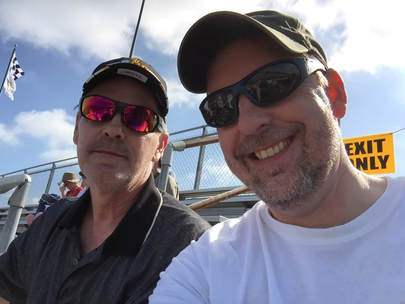|
Hello, Friends! Welcome to Nighthawk Gliders! We are very excited to announce our new website! Thank you so much for stopping by and visiting us. If you are interested in "enjoying flight and enjoying life," then this is the place to be! I suppose an introduction is in order... yes?  In this picture we have the Williamson brothers. I am the scruffy guy on the right, Brad. The other scruffy guy on the left is my brother Bruce. On September 15th, 2016 we decided to enjoy flight and enjoy life by starting a YouTube channel and website called "Nighthawk Gliders." Why did we start Nighthawk Gliders?
Well, we did so initially to have some fun and show off our fun-flying balsa gliders... But, we quickly realized our channel can serve a better and even bigger purpose. Instead of just "showing off" our creations, we want to inspire others in building their own aircraft. Therefore, not only do we want our channel to be fun and entertaining, but we want it to be informational, resourceful, and educational. Are we experts? No, we are NOT "experts," not by any stretch of the word. We do NOT have a Ph.D. in Physics, we are NOT engineers, and we've never contributed before to the field of aeronautical engineering. For the most part, we're just a couple of guys who strongly believe that learning NEVER stops after high school or college and we enjoy a hands-on approach to solving problems. At a minimum, we hope to acquire some knowledge in this field, we want to share and teach you something new! What will you find here and on our YouTube Channel? 1) First and foremost-- you'll find family-friendly content. Our channel appeals to folks of all ages. We inspire the younger kids to watch us and learn something new about flight. We also encourage the "older kids" to share and watch our channel with their children and/or grandchildren! 2) You'll see a showcase of our creations and watch us flying them. We're always learning and experimenting with new designs, improving flight endurance, and tinkering with performance. That's just fun for us! All in all, I know we're all just standing upon the shoulders of giants. But, we are starting on the ground floor here and learning the basics-- and we hope to work our way up to becoming experts in this field. (And boy, do we have a long way to go!) 3) You'll find some detailed tutorials on how to build some of our gliders. Yeah, we're spilling the beans on our techniques. We encourage everyone to join us, learn something new, and try building something fun today. We hope our video tutorials can be useful for everyone, including schools, clubs, and/or educators. 4) You'll enjoy some silly-fun entertainment. Part of the fun on our channel is coming up with new and exciting ways to enjoy flight and enjoy life. Bruce and I are competitive-- we like to challenge each other with newly inventive and exciting games. Have you ever lost a glider in a thermal? Can your glider hit a target? What is your craziest design that flies? It's all about being inventive, having some fun! 5) And finally, you'll see us doing collaborations and making new friends with those who share a common interest in this hobby/sport of flight. There are a lot of people out there who are enjoying flight and enjoying life-- and that is awesome! Please subscribe to our YouTube channel, join our community, and feel free to participate in our discussions. As we live and learn all that is joyous about flight, we are looking forward to providing you with helpful videos, information, resources, blogs, etc. We also encourage you to join us and share your learning experiences with us. Will you participate in our discussions and share with us what you have learned too? Are you willing to show us your successes and failures? Let's all fly together and solve some challenging problems. We think this is going to be fun and exciting time for everyone! Well, thanks again, for joining us here at Nighthawk Gliders! Until next time, my friends... Enjoy flight and enjoy life. Brad & Bruce Williamson
5 Comments
Herbert Kuttner
11/4/2018 09:34:28 am
I love tie videos but they go so fast that I do not have time to record the supply list of balsa / glue etc
Reply
Brad
12/3/2018 08:59:02 am
Hi Herb,
Reply
12/1/2018 08:11:04 pm
Hey Brad and Bruce!
Reply
Brad
12/3/2018 09:49:28 am
Hi Mike,
Reply
Leave a Reply. |
Details
AuthorBrad Williamson, co-creator of Nighthawk Gliders, enjoys learning about the many aspects of flight and aeromodelling-- especially when it involves free-flight gliders made from balsa wood. From 2012-2016 he helped coach Science Olympiad teams for a local middle school. In the state of Indiana, his students placed 1st in rotor egg drop, 3rd in Balsa Gliders, and 3rd in Helicopters. Since then, Brad was hooked on building and flying things made from balsa. His contributions here stem from his love around the hobby of flight and his desire to be creative and share information. Along with his brother, Bruce, their goal is to inspire a new audience (be them young or old) to simply "enjoy flight and enjoy life!" Archives
August 2020
Categories |
 RSS Feed
RSS Feed